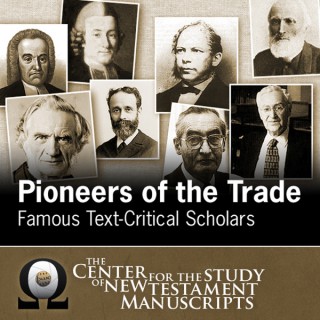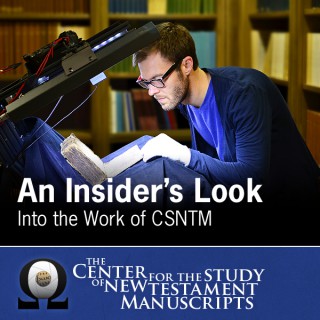The Basics of New Testament Textual Criticism
Follow The Basics of New Testament Textual CriticismTextual Criticism remains today as one of the most overlooked disciplines in Biblical studies. In this collection, Dr. Daniel B. Wallace of the Center for the Study of New Testament Manuscripts (CSNTM) teaches people from the lay to the scholarly level a
Center for the Study of New Testament Manuscripts (CSNTM)
- Aug 15, 2011 LATEST EPISODE
- infrequent NEW EPISODES
- 9m AVG DURATION
- 15 EPISODES
More podcasts from Center for the Study of New Testament Manuscripts (CSNTM)
Latest episodes from The Basics of New Testament Textual Criticism

In this video, Dr. Daniel B. Wallace of the Center for the Study of New Testament Manuscripts (CSNTM) gives an introduction to the practice of New Testament Textual Criticism (NTTC) with a focus on the definition of NTTC. Dan holds that NTTC is defined by its goal to recover the wording of the no longer extant original text, or autograph, from the available, but variant, existing manuscripts (MSS).

Compared to the manuscript attestation of classical texts and secular histories, the New Testament is attested to by an embarrassment of riches. Dr. Daniel B. Wallace of the Center for the Study of New Testament Manuscripts (CSNTM) describes the favorable situation of New Testament textual criticism based on the number and variety of texts where the New Testament is recorded.

The practice of New Testament Textual Criticism (NTTC) is given greater depth by Dr. Daniel B. Wallace of the Center for the Study of New Testament Manuscripts (CSNTM) through providing an introduction to the use of external evidence. The three types of external evidence, namely, date and character, genealogical solidarity, and geographical distribution, are used to determine the usefulness of manuscripts (MSS) such as Codex W, p66, p75, codex 1739, and codex 1582.

Evidence for the original text of the New Testament can sometimes be found within the text itself. Dr. Daniel B. Wallace of the Center for the Study of New Testament Manuscripts (CSNTM) discusses how intrinsic evidence that supports a particular reading of the text can be discovered through the literary decisions of an author or the transcriptional editing by copyists and scribes.

The combination of external evidence and internal evidence is used to resolve the textual problem that exists in Revelation 1:4. Dr. Daniel B. Wallace of the Center for the Study of New Testament Manuscripts (CSNTM) uses the basic principles of textual criticism, to choose the reading that best explains the rise of the other(s), to come to the conclusion that the author, John, intentionally made a “grammatical blunder” for the purpose of making allusion to the Old Testament passage of Exodus 3:14.

In this video, the methodology of New Testament textual criticism (NTTC) is applied by Dr. Daniel B. Wallace of the Center for the Study of New Testament Manuscripts (CSNTM) to Matthew 27:16-17. The manuscript evidence is scrutinized and certain principles are applied in the process, such as the dictum that the best reading is the one that best explains the rise of the other readings.

The textual problem found in Romans 5:1 reveals a textual variant represented by the subjunctive and indicative forms of a verb. A one-letter difference--between an omicron and an omega--determines whether the verse should be read, “let us have peace” or “we have peace.” Dr. Daniel B. Wallace of the Center for the Study of New Testament Manuscripts (CSNTM) walks us through this issue.

Dr. Daniel B. Wallace of the Center for the Study of New Testament Manuscripts (CSNTM) introduces the critical discussion of variants by defining what counts as a variant in the New Testament text. Editorial marks such as punctuation do not count whereas such differences like spelling and word order do.

The right and wrong methods of counting the number of textual variants we have amongst the manuscripts of the New Testament text is discussed by Dr. Daniel B. Wallace of the Center for the Study of New Testament Manuscripts (CSNTM). The wrong way to count them is to count manuscripts that have a particular wording. The right way to count them is to count each difference in wording regardless of how many manuscripts support them. This brings the actual count of textual variants to 400,000-500,000.

Not all variants are created equal! Dr. Daniel B. Wallace discusses the importance of giving proper weight to different types of textual variants within the Greek New Testament. The work of textual criticism is to give the proper value and meaning to variants that are both viable and meaningful, while taking into account the variants that do not make as much of an impact on the meaning of the text.

The classification of the New Testament Manuscripts by their contents is here discussed by Dr. Daniel B. Wallace of the Center for the Study of New Testament Manuscripts (CSNTM). The manuscripts are split into four groups: the Gospels, the Pauline letters and Hebrews, Acts and the general letters, and Revelation. Dr. Wallace shows that there is a great disparity between the number of manuscripts that contain the Gospels and those that contain Revelation, and he explains why this is significant.

There is a fourfold categorization of the Greek New Testament manuscripts. These four categories are papyri, uncials or majuscules, minuscules, and lectionaries. This system of categorization is discussed by Dr. Daniel B. Wallace of the Center for the Study of New Testament Manuscripts (CSNTM).

Dr. Daniel B. Wallace of the Center for the Study of New Testament Manuscripts (CSNTM) lists the different forms and versions in which the New Testament is preserved outside of the Koine Greek. These different forms vary from talismans and Greek ostraca to official translations in Latin, Syriac, and other languages.

A discussion of both the value of and the problem with using Non-Greek versions of the New Testament for the purpose of New Testament textual criticism is carried on by Dr. Daniel B. Wallace of the Center for the Study of New Testament Manuscripts (CSNTM). Dr. Wallace shows how versions of the New Testament such as the Latin Version, the Coptic Version, and the Syriac Version are significant for recovering the original autographic text of the New Testament.

Dr. Daniel B. Wallace of the Center for the Study of New Testament Manuscripts (CSNTM) discusses the preservation of the New Testament in the patristic writings. While there are valuable benefits of having the New Testament in the church fathers – some 1 million quotes – there are a few problems that need to be kept in mind, such as whether a particular quote is an allusion from memory or copied from the text itself.














